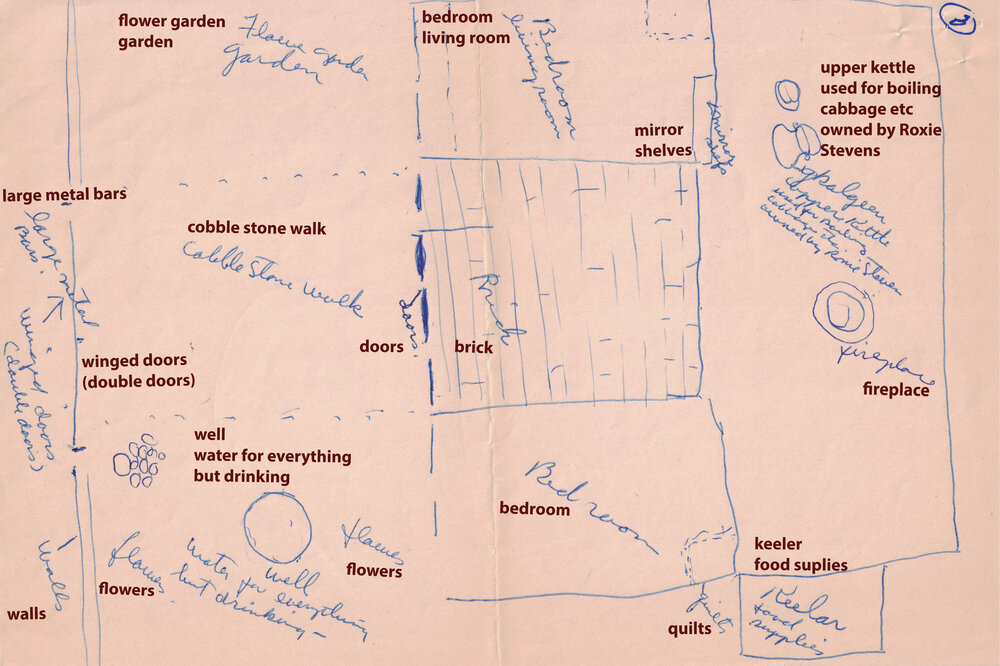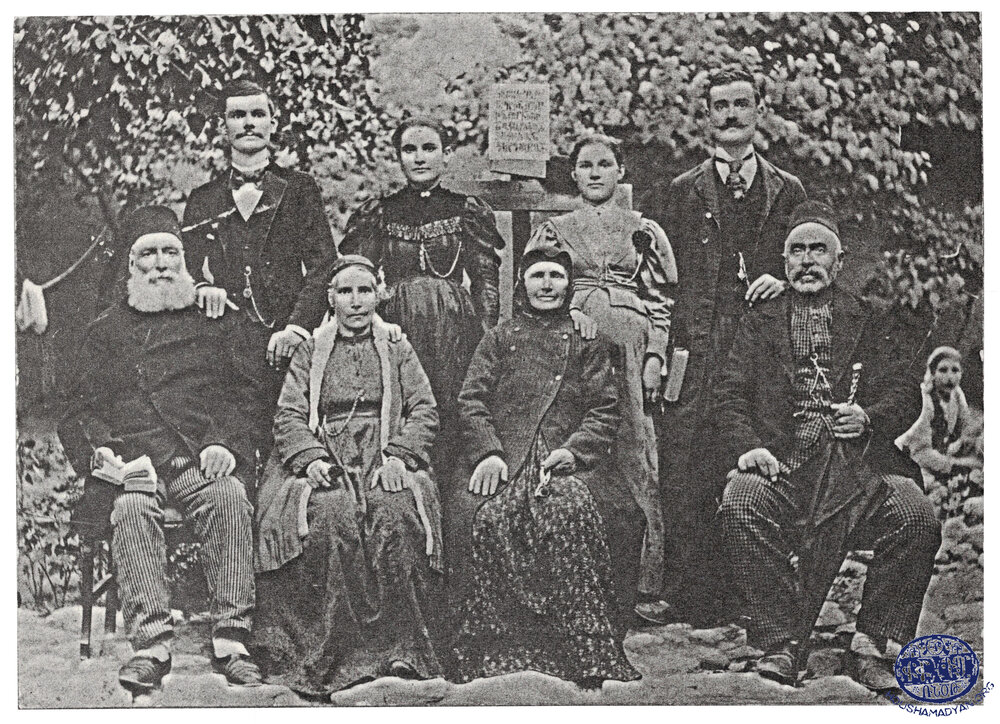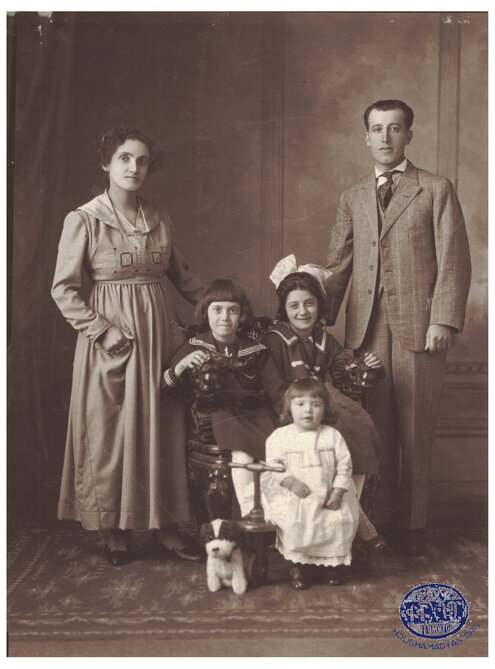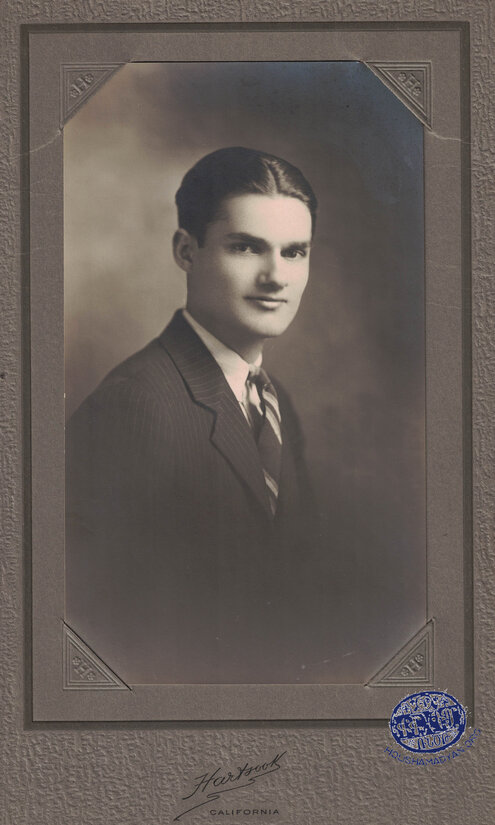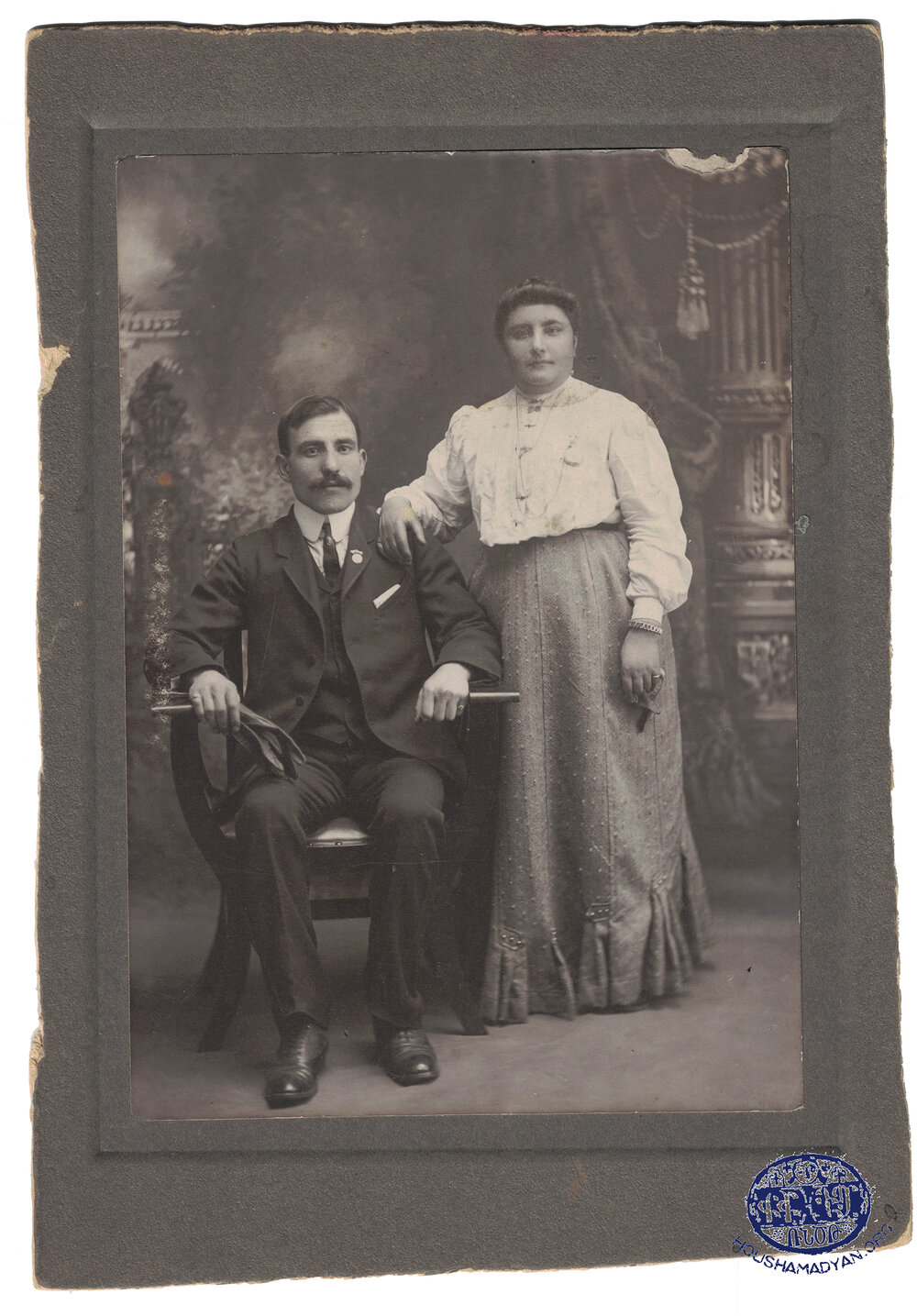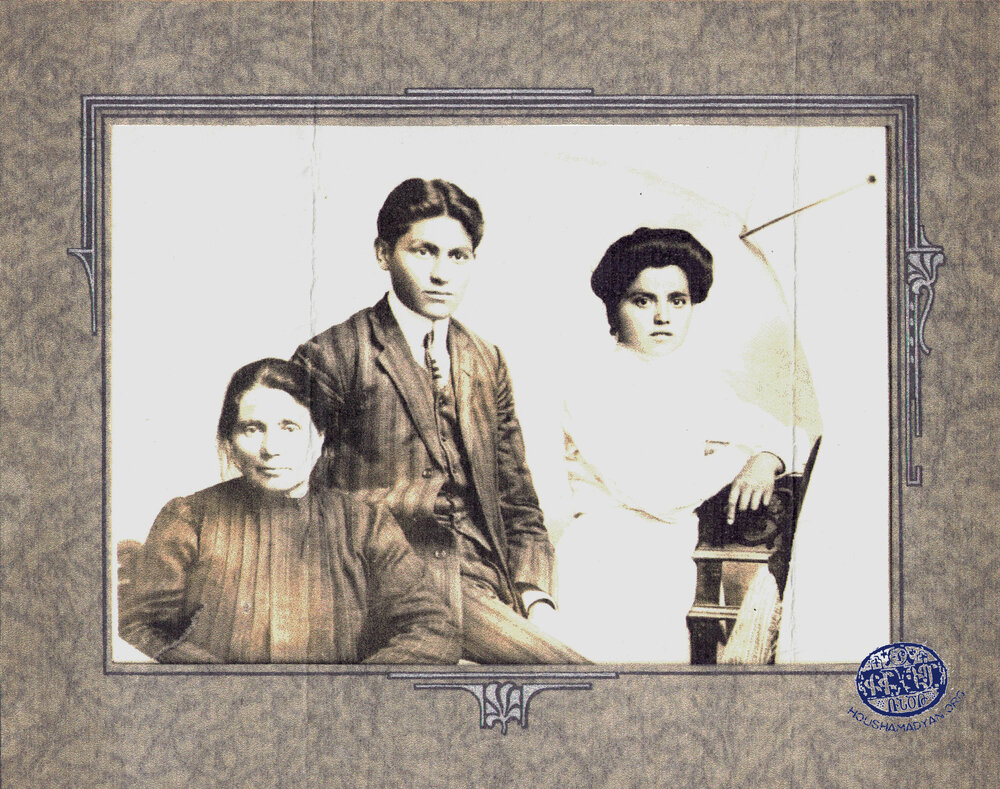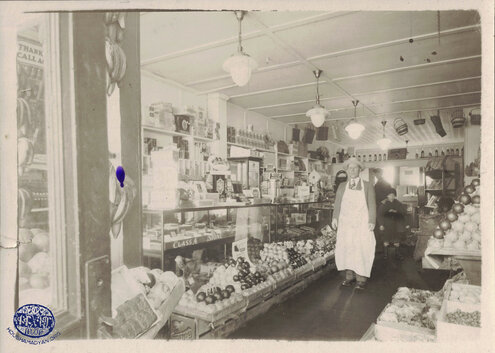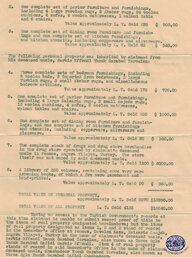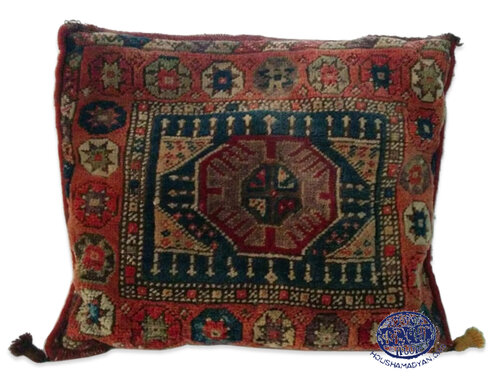Thompson/Nielsen Collection - Iowa City and Berkeley, USA

The creation of this page dedicated to the Torosian and Shakargian families from Kayseri/Gesaria and Erzincan/Yerznga respectively, was made possible thanks to Nazaly/Nancy Jean Thompson and her brother James Nielsen. Over a period of approximately one year, Nancy sent us all her family treasures very meticulously and wrote all the texts published here with great care. Nancy and James’s parents, Roy and Betty Nielsen, had also provided considerable assistance in organising and saving the materials and information, while their aunt Esther Fuller was the primary data gatherer of the family.
Nancy's maternal grandfather, Yesai Torosian, was from Kayseri/Gesaria and her maternal grandmother, Azniv Shakargian was from Erzincan/Yerznga.
Overview of the Shakargian Family:
Khatchadour Shakargian and Helene Shamegian had 7 children:
1. Stepan (1851-1923); he married Lucien Donegian (1849, Morik-1927); the couple left Yerznga in 1902 intending to go to Cairo but went to the US (Fresno) instead; their children are: Arshag, Azniv/Agnes (later Torosian), Nartouhi, Eva (later Kapigian).
2. Monig.
3. Garabed married Sarah Morjig; their children are: Miriam, Haigazoun, Neshan, Satenig, Krikor, Kevork, and Hampartsoum.
4. Sark.
5. Setrag (used the last name Shakarian), he married Mariam Kapigian; the couple left Yerznga in 1902 and went to Cairo; their children are: Vergine (later Tchakedjian), Vehazoun (later Kutchukian), Tsolag, Haig, and Armenouhi (later Bakerdjian).
6. Eternana, she married a person with the last name of Morijigian; their children are: Haig, Haiganoush (later Boronian), and a daughter (who later married a Terzian).
7. Mardiros, he married a person with the first name of Yeritigen (? yeretsgin, pastor’s wife).
Stepan and Setrag and their families went by horseback from Yerzinga to Trabzon where they boarded a boat. They were heading to Egypt where they had relatives, but there was some problem with quarantine in Marseilles and only Setrag ended up going to Cairo, while Stepan and his family went to the US (Fresno CA).
A rough sketch of the floor plan for Stepan and Lucien’s house and some of the furnishings of their home in Yerznga are shown in the notes made by Nancy's aunt, Esther. These are also displayed further down in this page.
The Shakargians were Protestant in Yerzinga; Stepan’s family attended a Protestant church in Fresno and one of Setrag’s descendants, who is a Protestant Armenian pastor, reports that his grandparents and great grandparents worshipped with Protestant Armenians in Cairo. Further, Nancy's grandmother is believed to have attended the Chrisdinian school for girls in Yerznga where, in 1894, she made the embroidery sampler displayed on this page.
Overview of the Torosian family:

Haroutyoun/Bernard Torosian was born in 1858 (he died at a young age), he married Miriam Jerahian who was born in 1858 (she died in 1924, in Turlock CA).
Haroutyoun/Bernard Torosian and Miriam Jerahian had 6 children:
1. Yesia Torosian (1884, Fenese-1960, USA), he was altar boy in an Orthodox church in his home town, when he was 13 he left to work as a shoemaker with an uncle in Constantinople. In 1908 he married Agnes Shakargian in the US.
2. Harry Torosian (1878, Fenese-1969, USA). When his father died, he was sent to live with an uncle in Constantinople. After living there 5 years he and his friend Krikor Baltaian decided to leave. He married Valentine Peshdimaljian (1886–1947).
3. John (1879, Fenese-1958, USA). He married Paros Takoushian (1893–1978) in 1912. She came to the US with his mother when she was 14 as she had been promised to marry John at birth.
4. Mariam (1880, Fenese-1916, USA), she married Garabed Nourjanian (he escaped and went to the US in 1907; Mariam and their 5 children came in 1913).
5. Arousyag (born in 1886).
6. Roupen
This is a group photo of two of Azniv/Agnes’ paternal uncles and her sister.
The person in the far right of the back row is Azniv’s uncle Setrag. Setrag’s wife, Miriam Shakargian (born Kapigian), is to his left. He and his family left Erzincan/Yerznga together with Azniv and her family in 1902 intending to immigrate to Cairo, Egypt. However, due to quarantine problems in Marseilles, only Setrag’s family went to Cairo. Azniv and her family went to the US.
The person in the far right of the front row is Azniv’s uncle Mardiros. His wife is to his right. Her first name was Yeritigin (probably “yeretsgin” in Armenian, meaning the pastor’s wife.
The second person from the left in the back row is Eva, Azniv’s older sister. Her husband, Mardiros Kapigian is to her left. And the parents of Eva’s husband and Setrag’s wife, Alex and Maritsa Kapigian are seated in front row on the right. Because Eva was already married in 1902, she was not part of the group, which left Erzincan/Yerznga.
This photo was taken in 1906, four years after Stepan and his family arrived in the US. Standing from left to right in the back row are: Azniv/Agnes Torosian (born Shakargian, she is Nancy's maternal grandmother), her brother Arshag and his wife, Nartouhi Pojojian (alternates Nartoo, Pazozian, Posozian). The adults sitting from left to right in the front row are Nancy's great-grandmother, Lucien Shakargian (born Donegian), and great-grandfather, Stepan Shakargian. All three of the children are Arshag Shakargian’s daughters. From left to right they are: Aroxy Phinney, Armen Daugherty and Arsh Stone.
We believe this is a photo of Harry Torosian's wife's parents, Mr. and Mrs. Peshdimaljian. Harry wife's name was Valentine Torosian, born Peshdimaljian, she was born in 1886 and died in 1947. The photograph depicts, Mr. and Mrs. Peshdimaljian, Valentine's mother and father. We do not know their given names; the photograph was most probably taken in the Ottoman Empire.
There is conflicting information about the identity of these two individuals.
Based on Azniv/Agnes Torosian's (born Shakargian) note on the back of a copy of this photo, the photographed people are: Krikor Shakargian and his wife Bizar (Baidzar?). Krikor was Garabed Shakargian (Nancy's grandmother Azniv/Agnes' uncle) and Sarig's son who was killed on his way to America via Erzurum/Garin. The back of this photo says that Krikor was killed at the same time as another person who is identified as the husband of Mariam, Garabed's daughter.
However, when we look at the back of the original photo of these two people someone has written that the woman is Haiganoush, who was the daughter of Garabed's sister Eternana. If this is true, the man may be her husband Aharon Baronian.

1. This is the wedding photo of Nancy's grandparents Yesia Torosian and Azniv/Agnes Torosian (born Shakargian). They were married in 1908 in the US.
2. This is a photo of the Yesia Torosian family in Turlock (California) about 1915. The three girls from left to right are: Roxy (seated next to Azniv/Agnes), Betty (in the white outfit) and Esther (wearing a bow in her hair). Betty Torosian is Nancy's mother. Standing from left to right are: Azniv/Agnes Torosian (born Shakargian) and her husband Yesia Torosian.
Photo of Nancy's great-great-grandmother, Helene Shakargian (born Shamegian) in front of my Nancy's grandmother's home in Erzincan/Yerznga.
Sitting from left to right are: Haiganoush, Azniv/Agnes' Shakargian's (later Torosian) cousin, Haiganoush was the daughter of Azniv/Agnes' aunt Eternana, the latter's husband had the last name Morijigian, the old woman on the right is Helene Shamegian (later Shakargian), she is Azniv/Agnes' paternal grandmother.
The little girl standing in the middle is Miriam, one of Azniv/Agnes' a cousins, she was the daughter of Azniv/Agnes' uncle Garabed and his wife Sarah. Miriam has a large piece of candy in her hand. It is in the shape of a flower and was made for her by her Uncle Setrag. He and several other Shakargian brothers were in the candy and wholesale sugar and coffee trade. The ceramic chickens made by Azniv/Agnes looked like some of the candy her family used to make.
The baby in Helene Shakargian's (born Shamegian) lap is probably Sherman Baronian, Haiganoush's son.

The Torosian men: in the back row, the two adults standing from left to right are: Yesia and John Torosian. The two younger boys standing in the middle in front of each other are Harry's sons. In the front row, the two adults sitting from left to right are: Garabed Nourjanian (Miriam's daughter Mariam's husband) and Harry Torosian.
1. Miriam Jerahian, who was Nancy's grandfather's mother, born in Jerusalem 1858, is standing on the left, she is photographed with her son John (standing in the middle) and a woman named Paros Takoushian. Miriam immigrated with Paros who was to be John's wife. Since John and Paros married in 1912, we assume that Miriam and Paros went to the US around 1912 or before.
2. Standing from left to right are: Harry Torosian's wife Valentine Torosian (born Peshdimaljian), Harry's mother in law, and Harry Torosian.
This photo depicts the family members and relatives of Yesia Torosian, Nancy's maternal grandfather.
Harry Torosian (born on May 2, 1878 in Kayseri/Gesaria) and his wife, Valentine Peshdimaljian (1886-1947) are photographed. Harry was the oldest son who immigrated to the US, in 1896. He settled on the East Coast and was instrumental in helping his brothers John and Yesia, his sister Mariam and his mother Miriam to immigrate later.
Harry and Valentine met and married in the US. Harry had assumed responsibility for his younger siblings as their father, Haroutyoun/Bernard, seems to have died early. Harry ran a grocery store and was a well-liked citizen. He attended a Congregational Church. He visited CA periodically to keep in touch with his brothers John and Yesia. His sister, Mariam, and her husband, Garabed Nourjanian, were assisted by Harry as well.
It seems that both the Torosians and the Shakargians were Protestants perhaps even before they went to the US.
1. Backside of the photograph, the writing says that this is gifted to Mrs. Azniv Torosian as a souvenir of their friendship and kinship, date: March 14, 1909, place: Erzincan/Yerznga. Signed: Kevork Shakargian.
2. The adults in the photo are clearly labeled as Haiganoush Baronian and Haig Morjig(ian). The photo was taken in Erzincan/Yerznga circa 1909. We believe these two individuals are the daughter and son of Nancy's grandmother's aunt Eternana Shakargian, who married a man with the last name of Morijigian.

3. Photo of Yesia Torosian, he worked at various places in the US. This photo shows him working in a foundry in Massachusetts.
4. Yesia Torosian and his store in Turlock CA. This photo is the front of a post card. It shows the exterior of the store rather than the interior, which is shown in the previous photo.

Various documents from the family archive. These pages were part of a claim Nancy's grandparents, Yesia and Azniv/Agnes, made under the auspices of the US Department of State in 1933. The claim was addressed to the Turkish authorities via the government of the United States, and was in reference to the law for compensation for the Torosian family’s loss of their real estate and properties. This was after many members of the Torosian family, including Nancy's great grandmother, had immigrated to the US. The claim was denied. Some of the documents give the exact location and fairly complete description of the Torosian property in Kayseri. For a more legible version of the property description, please click HERE.
Azniv/Agnes Torosian’s (born Shakargian) daughter, Esther, drew this sketch of the floor plan of Azniv’s home in Erzincan/Yerznga which is in the background of the previous photograph. The sketch was based on Azniv’s memories of her home. Apparently there was a place to get water from a spring in the front yard. The sketch also contains crude drawings of some of the furnishings, including a jug, which is photographed in the heirloom section.

Family heirlooms
The materials displayed in this section are part of Nancy Thompson's collection and have been preserved with great care. Nancy sent photographs of each item, many of which came from Erzincan/Yerznga when Azniv Shakargian (later Torosian) immigrated with her family in 1902.
Ceramic chicken and rooster, we believe that the larger ceramic was made by Nancy's aunt Esther and the smaller one was made by her grandmother Azniv/Agnes Torosian (born Shakargian). Azniv/Agnes would say that these chickens and roosters represented forms of candy made by her father and uncles, these were one of the other shapes for candy her father and his brothers would make back in Erzincan/Yerznga, when they were in the candy business. The taller ceramic is 4.5 inches (11,4 cm). The smaller ceramic is 3.5 inches (8,89 cm).
This is a pair of socks that Nancy's grandmother, Azniv/Agnes Torosian (born Shakargian) made in Yerznga. The measurements are as follows: heal to toe 8.5 inches (21,60 cm); bottom of heal to top of sock 16.5 inches (41,90 cm); widths - at foot 3.25 inches (8,25 cm), at ankle 3.25 (8,25 cm) inches, at top of sock 4.25 inches (10,80 cm).
This is an image of Nancy's grandmother's sampler. She was born in 1886 and made this sampler in 1894. She made it while going to a missionary school in Erzincan/Yerznga. The top part is the Armenian alphabet. In the lower left corner there are various animals. Her initials "Ա. Ս. Շ." A. S. Sh. in Armenian for Azniv Stepan Shakargian. The visible portion measures 19 inches (48,26 cm) by 11.25 inches (28,57 cm).
We believe all pieces of lace came with Azniv/Agnes' family from Erzincan/Yerznga, they are all measured from tip to tip; i.e. from the outermost part of each piece.
Lace 1: this piece is 6.5 inches (16,51 cm) from the tip of one point to the tip of the opposite point.
Lace 2: this one is 8.5 inches (21,59 cm) from the tip of one lobe to the tip of the opposite lobe.
Lace 3: this one is 7.5 inches (19,05 cm) from the tip of one edge to the tip of the opposite edge.
Lace 4: this one is 8 inches (20,32 cm) from the tip of one edge to the opposite tip.
This is a water jug/pitcher. Esther Torosian made a sketch of this jug in the notes she took during a conversation with Nancy's grandmother, Azniv/Agnes Torosian (born Shakargian). The sketch is located on the note pages displayed above. The jug measures 15 inches (38 cm) tall and the widest part has a diameter of 25 inches (63,5 cm). It is from copper and we believe the lid and handle are attached via riveting. The notes also show a rough sketch of the family home back in Yerznga. Apparently, there was a place to get water close by. Family members probably used this jug to bring water from the spring.
Tass (in Armenian)/water cup. It was brought from Yerznga by the Shakargian family in 1902. It was used to pour water over oneself while bathing. Azniv/Agnes Torosian (born Shakargian) said that in Yerznga they would wash themselves with a barrel of water, using the tass to pour water on their bodies. Then they would go into the communal bath with a relatively clean body. Another thing Azniv/Agnes said is that the bath was a place for mothers to check out the bodies of possible brides for their sons. Also, she recalled the pleasant feel of sitting in the lap of older women with soft, ample skin.
The diameter at the top of the tass is 8 and 1/16th inches (20,72 cm). The diameter at the bottom is 6 inches (15.24 cm). The depth of the tass is 2 and ½ inches (6.35 cm).
Postcards from the family collection
The postcards displayed in this section are part of the Nancy Thompson family collection. They mainly display Armenian Dashnak (Armenian Revolutionary Federation) revolutionaries.
Revive Us Again
This is another song that Azniv/Agnes Torosian (born Shakargian) performs, it is a Protestant hymn called "Revive Us Again", Azniv/Agnes sings the Armenian version of the hymn.


